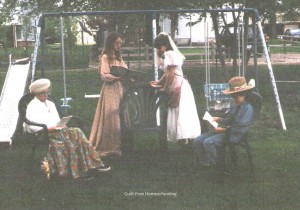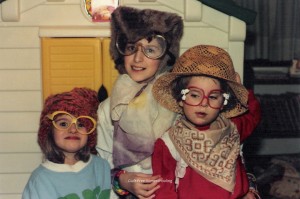An interesting idea occurred to me when we were driving home late a few nights ago. My throat was dry, so I pulled a box of Tic-Tacs out of my purse, shook some pieces into my hand (without turning on a light), and popped them into my mouth. As I rolled the candies around with my tongue, I began trying to count them to see just how many there were. The box that usually releases only one or two pieces with a good shake had instead given me a mouthful in the dark. One, two. One, two, three, four. No. One, two, three… One… two… three… four… FIVE? Yes, Five. A number that would have been very simple to identify with my eyes in a lighted situation was suddenly very difficult to count with just my tongue!
That experience set my mind to working overtime. How simple is it to count objects that I can see? How much more difficult is it to count objects that I can NOT see? The whole idea of blind counting made me consider the possibilities of math as a tactile experience. I have often carried coins in my jeans pocket and had to pull out a handful and look at them to select just one or two. If I was more adept at tactile identification, perhaps I could pull out only the coins I needed!
So here is my challenge for the day: experiment with tactile counting. I recommend trying it with fingers first, not letting your young children pop random objects into their mouths — although that can be an interesting lesson for more advanced students (who are less likely to swallow). Expanding the awareness of number values to tactile skills and not just visual skills will allow the student to count quickly and easily by touch, even when seeing the objects in question is difficult or impossible.
I tested my own tactile counting skills by spreading a towel on the table, folded in half, with the fold farthest away from me. Then I closed my eyes and grabbed a large handful of goodies from my Activity Jar and inserted the objects between the layers of the towel. (The towel kept balls, marbles, and other small, round objects from rolling away.) Carefully keeping the upper layer of the towel in place to conceal the objects, I slipped my hands underneath it and began feeling the hidden treasures. To my surprise, there were a lot of things inside my towel — many more objects than I expected to find.
I eventually pulled one hand out and began writing notes of what I had found, so I could record how many buttons and how many game tokens were included in this cache. I wrote down each basic category of items and used tally marks for the duplicates. When I was satisfied that I had sorted and counted everything successfully, I opened up the towel to check my accuracy. Oops. Close, but not perfect! I had miscounted the buttons: 14, instead of 15; but I had correctly identified five different types of game tokens: large, small, ridged, smooth, and cardboard (not plastic like the others). I had also correctly identified a coin as feeling different from the plastic game chips and accurately concluded (by touch only) that the coin was a penny, not a nickel or dime.
This was such a fascinating challenge that I repeated it several more times! Once, I purposely sorted out a large group of flat game tokens from my Activity Jar, some smooth and some with ridged edges. Placing those inside the towel, I attempted to sort them into two piles and count how many were in each pile. I accurately counted the ridged tokens, but I was off by two when I counted the smooth chips. My conclusion was that the thin, smooth chips could slip out of my hands unnoticed much more easily than the ridged chips could.
How about some other variations of this tactile math challenge?
- Blindfolded; count objects with your fingers
- Blindfolded; feel and count objects in a box on the floor with your toes
- Use several sizes of the same shape, such as a variety of coins
- Use a variety of shapes and sizes of different objects, such as buttons
- Count behind your back, feeling objects placed into your hands by a helper
- Feel objects placed inside a sack, box, or pillowcase (so you can’t see them)
- For older or advanced students: tiny, hard candies in the mouth to count with the tongue. Tic-Tacs work well, since they are quite small and don’t melt quickly.
The variations using toes or tongue develop tactile skills beyond the usual finger skills. Even a student who can quickly count or identify with finger-touches will find it a challenge to repeat the assignment with toes. I suggest starting with fewer than ten objects for toe-counting and using 3-dimensional objects, not flat items like coins.
For tongue-counting, be sure the student is not likely to choke or swallow the candies, and start with fewer than five small pieces. Keeping the head tilted forward can also prevent accidentally swallowing the candies. I cannot recommend putting non-edible objects in the mouth, nor do I suggest using anything larger than a plain M&M candy. Hard candies work better for this experiment than do soft, chewable candies. Tic-Tac candies are ideal: small and solid.
One more variation would be to turn this into an auditory activity by counting sounds. Conceal your hands behind a large book or similar partition and tap quickly several times, while your student attempts to count how many taps he hears. A more complex version would involve listening to music and counting notes, beats, or instruments heard. Take this activity outdoors and listen for vehicles, horns, or bird songs.
Math is primarily a visual task, but stretching our abilities and learning to sort and count with our other senses will bring the benefits of increased skills and a related increase in thinking power. And just imagine the fun of impressing your friends with your ability to count the change in your pocket without looking!






 Guilt-Free Homeschooling is the creation of Carolyn Morrison and her daughter, Jennifer Leonhard. After serious disappointments with public school, Carolyn spent the next 11 years homeschooling her two children, from elementary to high school graduation and college admission. Refusing to force new homeschooling families to re-invent the wheel, Carolyn and Jennifer now share their encouragement, support, tips, and tricks, filling their blog with "all the answers we were looking for as a new-to-homeschooling family" and making this website a valuable resource for parents, not just a daily journal. Guilt-Free Homeschooling -- Equipping Parents for Homeschooling Success!
Guilt-Free Homeschooling is the creation of Carolyn Morrison and her daughter, Jennifer Leonhard. After serious disappointments with public school, Carolyn spent the next 11 years homeschooling her two children, from elementary to high school graduation and college admission. Refusing to force new homeschooling families to re-invent the wheel, Carolyn and Jennifer now share their encouragement, support, tips, and tricks, filling their blog with "all the answers we were looking for as a new-to-homeschooling family" and making this website a valuable resource for parents, not just a daily journal. Guilt-Free Homeschooling -- Equipping Parents for Homeschooling Success!

Recent Comments